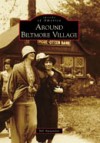Though Around Biltmore Village (2008) by Bill Alexander has the initial look and feel of a history book—in the vein of fellow Arcadia Publishing release Asheville’s River Arts District—there’s more to the book than meets the eye. Or, perhaps more aptly, there is exactly that which meets the eye.
I’m referring to the book’s lovely cover image. In sepia tint, the always fashionable Edith Vanderbilt, ornate shawl clutched about her shoulders and cloche obscuring her eyes, smiles broadly as she strolls with a friend past the former Biltmore-Oteen Bank on Lodge St. At first glance this image is little more than charming: a slice of local history paired with minor celebrity. A nice picture, a pretty woman. But, in fact, it’s the perfect introduction to Alexander’s book. Because, although this is the story of Biltmore Village—the tourist-attracting row of shops culled, over a hundred years ago, from rutted dirt roads and farm land—it’s also the story of the Vanderbilt family who fashioned the area.
“The format of this book is intended to present only a glimpse into the captivating history of Biltmore Village,” writes Alexander in his intro. “…it was decided to focus mainly on the early history through the 1940s.” Like River Arts District, Biltmore Village is a photo scrap book with extensive captions telling not the whole story of the place, but offering up tantelizing morsels of history and glimpses simultaneously still present and all but vanished.
Here’s how that dichotomy works: The Smith-McDowell House, on the property of AB Tech, is still lovingly maintained and available for all to visit. But who knew that the antebellum mansion, constructed in 1840, was built by “James McConnell Smith, born on June 14, 1787, who is said to have been the first white child born west of the Blue Ridge in North Carolina”?
Or that the wedge of land where Biltmore Village now sits (its wagon wheel of streets and stuccoed shops still linking Asheville back to the near-divine collaboration of architect Richard Sharp Smith and landscape architect Frederick Law Olmstead) was once a sleepy farming hamlet known as Best?
Alexander includes a faded image of Best, with its tidy clapboard I-houses, as it looked prior to being bought by millionaire George Vanderbilt. “At the time,” the author writes of Vanderbilt’s purchase, “he had not envisioned that he would ultimately remove the scattered houses and buildings clustered around the railroad tracks along the river to make way for a model village of orderly streets with rental cottages, businesses, a church, and a school.”
Though Vanderbilt’s acquisition and development of the Biltmore Estate and surrounding area is well-documented and tight-knit to the story of Asheville on the whole, the next section of photos in Biltmore Village conveys another more intimate tale. Here, Cornelia Vanderbilt entertains guests prior to her 1924 wedding to John Francis Amherst Cecil. Here, she attends a 1928 art exhibit in Kenilworth Galleries, “the largest show in the South at that time.” In a few words, all the fun of the 1920s, the opulence and glamor of the Vanderbilt family and the high mood of the time is conveyed.
Alexander notes that, Vanderbilt influence aside, by the late 1800s Asheville was racking up pet names such as “Health-Seeker’s Paradise,” “Poet’s Dream” and “Madonna in the Mountains.” “As a result of the area’s prosperity and wide acclaim, Kenilworth Inn and other establishments sometimes used the phrase ‘Where Life Is Worthwhile’ to make their advertisements more appealing,” the author notes.
Around Biltmore Village is a quick read, but the well-edited collection of photos and detailed description of the Victoria Road neighborhood, Kenilworth and Biltmore Forest are likely to inspire readers to undertake further research. It’s the kind of book that Asheville locals and fans will keep close at hand both for reference and to share intriguing facts with visitors.
—Alli Marshall, A&E reporter




Before you comment
The comments section is here to provide a platform for civil dialogue on the issues we face together as a local community. Xpress is committed to offering this platform for all voices, but when the tone of the discussion gets nasty or strays off topic, we believe many people choose not to participate. Xpress editors are determined to moderate comments to ensure a constructive interchange is maintained. All comments judged not to be in keeping with the spirit of civil discourse will be removed and repeat violators will be banned. See here for our terms of service. Thank you for being part of this effort to promote respectful discussion.